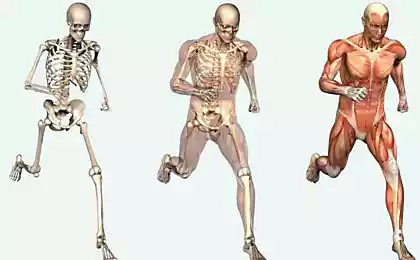869
Predisposition to diseases or Why we get sick
This wonderful article written by Dr. Stefano Carlino and George Vithoulkas, a doctor with international fame, skillfully wielding the method of classical homeopathy. In 1997 he was awarded the alternative Nobel prize for his book "a New model of health and disease".
This article is for those who have a goal to master the art of healing, where the treatment involves the awakening of creative healing forces of the body and always gives great success.
The ability to regulate the body during ordinary acute diseases is the Golden key to successful primary prevention of threat of chronic diseases.
Fundamentals
Throughout human life, from birth to death, there is a "continuum" in the sequence of natural diseases, acute and chronic. When acute diseases are not properly treated and the patient's immune system is weakened, the overall health of the individual is constantly at risk.
Ninety nine million eight hundred fifty two thousand four hundred ninety six
Acute diseases of childhood (not the epidemic, which mostly occur in systems that are more open to the external environment, namely the respiratory, digestive and epidermal) you need to treat carefully and do not crush the excess of drugs.
Otherwise the acute diseases will continue in modified form, something of a subacute inflammatory process, triggering the expression of genetic predispositions of the organism, resulting in chronic degenerative diseases.
All chronic conditions also have an inflammatory character, and that "inflammation" is the hallmark of all diseases.
If the body is in high temperature state is repeatedly aggressive loading the strong chemicals or excess, by the time a weakened immune system may be compromised so much that it can no longer react to high temperature, even when exposed to dangerous microorganisms.
One of the best examples of this is chronic fatigue syndrome, also called "polivirus syndrome". About this syndrome it is known that after virus infection can develop chronic condition, which sometimes is characterized by debilitating fatigue accompanied by muscle weakness, slight fever, painful lymph nodes, headache and depression.
Another example is acute viral hepatitis which can develop to liver dysfunction and eventually to liver cirrhosis, and acute rheumatic attack, ending chronic heart disease.
It is also known that elderly persons have a lower ability to raise a high temperature to exposure to an infectious agent.
In all such cases, when the high temperature as a reaction to a viral infection dramatically suppressed by appropriate means, the General level of health is seriously compromised. At the same time starts a new chronic degenerative condition to which the body has a genetic predisposition.
Have questions: "What is the relation between acute inflammatory processes and chronic diseases characterized by acute attacks?"and "Can they form the same line of the main violations?".
In acute conditions, after the aggressive intervention of strong chemicals, the overall health of the body will deteriorate, the body will refuse to protection at peripheral level and will continue to defend themselves on a deeper. If this new line of defense again attacked it to protect the body will descend on an even deeper level. The lowering of the defense will follow a hierarchical plan, which is probably the archetype for all humans — peripheral infections going deeper, more meaningful level.
Therefore, we can hypothesize that immune system whose main purpose is to maintain life at any cost, is structured so as to respond and react in different ways at different levels. The immune system has several levels of protection.
The first line of defense — fever.
If this is impossible from-for deficiency of the immune system, then the second line of defense will be sub-acute inflammatory process that is more vague and, therefore, stronger than undermines health, involving vital organs or systems.
The infinite complexity of human beingsIf we consider the human being as a whole, with mind, feelings, language, cognitive and creative abilities, it turns out that no other organism on this planet is not as complex and versatile as man.
It is therefore impossible that any kind of biochemical examination were able to give us a really definite answer on the health status of the individual at a particular time.
Laboratory tests can give us only a very General idea about what is happening at the biochemical level at a particular point, but cannot tell us the true overall condition of the body.
In this essay we will try to define some parameters that will help the medical practitioner to get a better idea about the General health of the patient.
Usually diseases begin to manifest from the very first days of life, when the environment becomes hostile to a newborn. We live in an environment in which there are disease-causing organisms and substances which force the body to defend itself.
The relation between the ability of the individual to adapt and to defend itself and the ability of the hostile organism to test the health of the individual strength determines whether the running process of the disease.
Obviously, for the beginning of the disease requires a stressor, but in addition the immune system must be in a weakened state and have a sensitized predisposition to a hostile body.
This is true at the first level — for example, there may exist a microbe and an organism sensitive to this microbe, and this germ may trigger microbial infection, or may be a substance acting on the sensitive organism, and this may be the cause of the disorder.
Another important reason, why we get sick is often the result of our own lifestyle, habits, food, thoughts, something that breaks the law of nature.
If we go beyond the limits set by nature, we inevitably lose the balance of homeostasis.
For example, if we exert ourselves beyond a certain level of strength at some point the body will react by developing a disease. If we nurture negative feelings we can provoke innate predisposition to chronic conditions.
"Predisposition to disease»Environment and lifestyle not enough to cause disease; there is a pathogenic factor, and the human body can be sensitive to it, and therefore will be able to develop an acute illness.
It is well known that two or more men can have a relationship with a woman infected with gonorrhea, but only one of them gets sick.
The body develops a disease, when there is a predisposition, a weakness to a certain pathogenic factor (not everyone will develop tuberculosis when exposed to Mycobacterium tuberculosis).
In other words, when the ratio between the strength of the stressor and strength of one of the protective mechanisms in favor of the stressor, the body gets sick, and if the superiority of the stressor very much, he could even kill the patient.
For the most part predispositions are innate but the use of certain drugs such as antibiotics, or exposure to free radicals or other chemical substances in the environment can cause DNA mutation, which can lead to the development of "acquired" predisposition, due to the weakening of certain organs or tissues.
Usually, about 104 DNA bases are damaged per cell per day, and each cell continuously repairs this damage to maintain genomic integrity.
Fortunately, this very complex mechanism is very effective, but its malfunction can play a role in the development of new dispositions.
Forty nine million three hundred twenty eight thousand two hundred sixty eight
Suppression of acute diseases as a cause of the beginning of chronic Let's develop this idea. There are diseases that we call acute, and chronic and degenerative disease. It is important to differentiate the cause of acute disease and chronic disorders. We want to understand what really happens to a person who is born and has health problems and how those problems develop over the life.
Almost everyone has health problems. No child born that does not have potential health problems at one time or another, either acute or chronic.
From the point of view of the febrile manifestations of a General pattern of disease in humans characterized two main groups:
1) with high temperature,
2) with a slight fever or no improvements.
The first group includes acute disease, the second chronic.
The main purpose of this essay is to show the connection between such diseases in one individual; in other words, to show that specific organism there is a continuum that defines the reaction of the immune system of the individual.
A very interesting observation is that many chronic diseases have exacerbations and remission.
Take for example a person suffering from epilepsy. At the stage of the crisis, it is an epileptic seizure, but what changes occur in his body outside of the stage of the crisis and what changes occur in order to have an epileptic seizure? The same question applies to multiple sclerosis, bronchial asthma, hay fever and other chronic degenerative conditions.
The next reasonable question: "whether a Comparable wave of exacerbations in chronic condition when the body's having a relapse with acute diseases?". If we can understand how the body functions, it is possible that we will create a theory of disease that has nothing to do with what is taught to students in medical schools.
In medical schools students are taught to recognize chronic and acute disease, describe the different syndromes, the characteristics of acute conditions, teach the special treatment of each of them. Is this knowledge sufficient for a doctor to cure a patient who came to him with an asthmatic crisis?
Usually the doctor knows what he needs to do with a asthma attack — he writes bronchodilators or if the attack is very strong, and gives the corticosteroids, and the patient will safely cope with an attack.
A little later the attack again and the condition will be worse. Over the years, the number of attacks grows, the attacks will be worse to treat, and eventually in front of us will have patients similar to that which I treated recently, he doubled over, couldn't breathe and talk to me.
The collection of symptoms as a reaction of the organism trying to restore the balanceToday medicine interested in, can we reduce the severity of asthma attacks or to cure the patient.
What are the parameters that tell us whether it is possible to cure the patient? For the therapist, these parameters are of great interest.
Suppose the child has often had the disease, over and over again, and he asked himself: "Why am I sick? My friend at school does not hurt or sick not so often".
Perhaps the answer lies in the complexity of the individual and their specific heredity. Within this hereditary predisposition his defense mechanism tries to adapt to the environment to survive, maintaining homeostasis, without the need of manifestation of a number of pathological symptoms.
The manifestation of pathological symptoms the body is actually trying to restore its lost balance. For example, if very hot, the body to cool off, reacts by sweating. But if cooling is sudden, the system will respond with the usual "cold", which is to restore the equilibrium, will give a high temperature, bringing the reaction to a pathological level.
The statement that symptoms are a negative manifestation that must be eliminated or suppressed is pure intellectual invention. We feel pain in a joint when the affected part needs to be immobilized in order to minimize local disturbance and to allow maximum and fast recovery.
The suppression of pain, which on one hand gives freedom of movement, can sometimes lead to severe organic damage; thus, the development of a symptom is a useful mechanism. Biology considers this to be a mechanism of development and adaptation.
We should therefore conclude that, for example, epidemics of childhood diseases is necessary to "train" the immune system and make it stronger to survive later in life.
Homeopathy can bring back the former strength of the immune systemThe body has the ability to respond to stressors, which should amplify, not suppress, to fight inflammation in a natural way, not forcing it to deeper levels.The time of response of the organism that create acute inflammation with high fever, as "a result of millions of biochemical reactions" aimed at restoring the lost balance — homeostasis.
If brute chemical force to interrupt and makes to disappear the process if it reaches a climax of its healing tasks, the result of which would be to restore homeostasis, the body needs to rebuild their protective mechanisms and the immune system decides to take a deeper line of defense, internalizer inflammatory process.
This is the starting point of a chronic disease. It can be collagenosis, lupus erythematosus, psoriasis, multiple sclerosis, neuromuscular disease, mental illness, autism, etc., and all of them are similar processes.
The important difference is that now the immune system can no longer muster the strength to rise in temperature to finish the cure. If there was a better system for the treatment of acute diseases more gentle means, then the immune system would not need to retreat and accept the disturbance on a deeper level.
Suppression of fever in pregnant women or in young children can cause autism. For autistic children rarely heat — they have been fever before they became autistic; for example, many of them had otitis of the middle ear with high fever that were suppressed by antibiotics or strong medicine. It is interesting to note that if they have a fever their autistic condition is improving. With the correct treatment the fevers will return, while autistic behavior improves dramatically.
Diseases of our modern society is increasingly affecting the peripheral and Central nervous system. Given the fact that the brain is most important organ, if we continue to push the disease to the center of the body, we will soon be witnessing a tremendous increase in mental illness.
Japanese researchers have discovered that they can cure cancer, causing a high temperature using a variety of antigens, and they have some really remarkable results. They introduced fever-inducing agents, the body reacted, and there had been improvement in the cancer. The same was observed in children with autism.
SummaryEvery human being diseases, acute and chronic, which are interrelated over the life of the "continuum common basis of disease", leading to terminal illness, which marks the end of life.
The question is whether the medicine is to discover ways to treat acute diseases, which form the beginning of the imbalance, more lenient means to support and strengthen the natural immune response and not suppressing her strong chemicals — possibly irreparably damaging it.
It seems that the protection mechanism, as a whole, has a "higher" intelligence that is able to maintain optimum balance under any stress.
The model we present here emerged after almost fifty years of direct observations of tens of thousands of patients.published
Authors: George Vithoulkas and Dr. Stefano Carlino
P. S. And remember, only by changing their consumption — together we change the world! ©
Source: //duhosin.ru/kontinuum-edinoy-teorii-bolezney/
This article is for those who have a goal to master the art of healing, where the treatment involves the awakening of creative healing forces of the body and always gives great success.
The ability to regulate the body during ordinary acute diseases is the Golden key to successful primary prevention of threat of chronic diseases.
Fundamentals
Throughout human life, from birth to death, there is a "continuum" in the sequence of natural diseases, acute and chronic. When acute diseases are not properly treated and the patient's immune system is weakened, the overall health of the individual is constantly at risk.
Ninety nine million eight hundred fifty two thousand four hundred ninety six
Acute diseases of childhood (not the epidemic, which mostly occur in systems that are more open to the external environment, namely the respiratory, digestive and epidermal) you need to treat carefully and do not crush the excess of drugs.
Otherwise the acute diseases will continue in modified form, something of a subacute inflammatory process, triggering the expression of genetic predispositions of the organism, resulting in chronic degenerative diseases.
All chronic conditions also have an inflammatory character, and that "inflammation" is the hallmark of all diseases.
If the body is in high temperature state is repeatedly aggressive loading the strong chemicals or excess, by the time a weakened immune system may be compromised so much that it can no longer react to high temperature, even when exposed to dangerous microorganisms.
One of the best examples of this is chronic fatigue syndrome, also called "polivirus syndrome". About this syndrome it is known that after virus infection can develop chronic condition, which sometimes is characterized by debilitating fatigue accompanied by muscle weakness, slight fever, painful lymph nodes, headache and depression.
Another example is acute viral hepatitis which can develop to liver dysfunction and eventually to liver cirrhosis, and acute rheumatic attack, ending chronic heart disease.
It is also known that elderly persons have a lower ability to raise a high temperature to exposure to an infectious agent.
In all such cases, when the high temperature as a reaction to a viral infection dramatically suppressed by appropriate means, the General level of health is seriously compromised. At the same time starts a new chronic degenerative condition to which the body has a genetic predisposition.
Have questions: "What is the relation between acute inflammatory processes and chronic diseases characterized by acute attacks?"and "Can they form the same line of the main violations?".
In acute conditions, after the aggressive intervention of strong chemicals, the overall health of the body will deteriorate, the body will refuse to protection at peripheral level and will continue to defend themselves on a deeper. If this new line of defense again attacked it to protect the body will descend on an even deeper level. The lowering of the defense will follow a hierarchical plan, which is probably the archetype for all humans — peripheral infections going deeper, more meaningful level.
Therefore, we can hypothesize that immune system whose main purpose is to maintain life at any cost, is structured so as to respond and react in different ways at different levels. The immune system has several levels of protection.
The first line of defense — fever.
If this is impossible from-for deficiency of the immune system, then the second line of defense will be sub-acute inflammatory process that is more vague and, therefore, stronger than undermines health, involving vital organs or systems.
The infinite complexity of human beingsIf we consider the human being as a whole, with mind, feelings, language, cognitive and creative abilities, it turns out that no other organism on this planet is not as complex and versatile as man.
It is therefore impossible that any kind of biochemical examination were able to give us a really definite answer on the health status of the individual at a particular time.
Laboratory tests can give us only a very General idea about what is happening at the biochemical level at a particular point, but cannot tell us the true overall condition of the body.
In this essay we will try to define some parameters that will help the medical practitioner to get a better idea about the General health of the patient.
Usually diseases begin to manifest from the very first days of life, when the environment becomes hostile to a newborn. We live in an environment in which there are disease-causing organisms and substances which force the body to defend itself.
The relation between the ability of the individual to adapt and to defend itself and the ability of the hostile organism to test the health of the individual strength determines whether the running process of the disease.
Obviously, for the beginning of the disease requires a stressor, but in addition the immune system must be in a weakened state and have a sensitized predisposition to a hostile body.
This is true at the first level — for example, there may exist a microbe and an organism sensitive to this microbe, and this germ may trigger microbial infection, or may be a substance acting on the sensitive organism, and this may be the cause of the disorder.
Another important reason, why we get sick is often the result of our own lifestyle, habits, food, thoughts, something that breaks the law of nature.
If we go beyond the limits set by nature, we inevitably lose the balance of homeostasis.
For example, if we exert ourselves beyond a certain level of strength at some point the body will react by developing a disease. If we nurture negative feelings we can provoke innate predisposition to chronic conditions.
"Predisposition to disease»Environment and lifestyle not enough to cause disease; there is a pathogenic factor, and the human body can be sensitive to it, and therefore will be able to develop an acute illness.
It is well known that two or more men can have a relationship with a woman infected with gonorrhea, but only one of them gets sick.
The body develops a disease, when there is a predisposition, a weakness to a certain pathogenic factor (not everyone will develop tuberculosis when exposed to Mycobacterium tuberculosis).
In other words, when the ratio between the strength of the stressor and strength of one of the protective mechanisms in favor of the stressor, the body gets sick, and if the superiority of the stressor very much, he could even kill the patient.
For the most part predispositions are innate but the use of certain drugs such as antibiotics, or exposure to free radicals or other chemical substances in the environment can cause DNA mutation, which can lead to the development of "acquired" predisposition, due to the weakening of certain organs or tissues.
Usually, about 104 DNA bases are damaged per cell per day, and each cell continuously repairs this damage to maintain genomic integrity.
Fortunately, this very complex mechanism is very effective, but its malfunction can play a role in the development of new dispositions.
Forty nine million three hundred twenty eight thousand two hundred sixty eight
Suppression of acute diseases as a cause of the beginning of chronic Let's develop this idea. There are diseases that we call acute, and chronic and degenerative disease. It is important to differentiate the cause of acute disease and chronic disorders. We want to understand what really happens to a person who is born and has health problems and how those problems develop over the life.
Almost everyone has health problems. No child born that does not have potential health problems at one time or another, either acute or chronic.
From the point of view of the febrile manifestations of a General pattern of disease in humans characterized two main groups:
1) with high temperature,
2) with a slight fever or no improvements.
The first group includes acute disease, the second chronic.
The main purpose of this essay is to show the connection between such diseases in one individual; in other words, to show that specific organism there is a continuum that defines the reaction of the immune system of the individual.
A very interesting observation is that many chronic diseases have exacerbations and remission.
Take for example a person suffering from epilepsy. At the stage of the crisis, it is an epileptic seizure, but what changes occur in his body outside of the stage of the crisis and what changes occur in order to have an epileptic seizure? The same question applies to multiple sclerosis, bronchial asthma, hay fever and other chronic degenerative conditions.
The next reasonable question: "whether a Comparable wave of exacerbations in chronic condition when the body's having a relapse with acute diseases?". If we can understand how the body functions, it is possible that we will create a theory of disease that has nothing to do with what is taught to students in medical schools.
In medical schools students are taught to recognize chronic and acute disease, describe the different syndromes, the characteristics of acute conditions, teach the special treatment of each of them. Is this knowledge sufficient for a doctor to cure a patient who came to him with an asthmatic crisis?
Usually the doctor knows what he needs to do with a asthma attack — he writes bronchodilators or if the attack is very strong, and gives the corticosteroids, and the patient will safely cope with an attack.
A little later the attack again and the condition will be worse. Over the years, the number of attacks grows, the attacks will be worse to treat, and eventually in front of us will have patients similar to that which I treated recently, he doubled over, couldn't breathe and talk to me.
The collection of symptoms as a reaction of the organism trying to restore the balanceToday medicine interested in, can we reduce the severity of asthma attacks or to cure the patient.
What are the parameters that tell us whether it is possible to cure the patient? For the therapist, these parameters are of great interest.
Suppose the child has often had the disease, over and over again, and he asked himself: "Why am I sick? My friend at school does not hurt or sick not so often".
Perhaps the answer lies in the complexity of the individual and their specific heredity. Within this hereditary predisposition his defense mechanism tries to adapt to the environment to survive, maintaining homeostasis, without the need of manifestation of a number of pathological symptoms.
The manifestation of pathological symptoms the body is actually trying to restore its lost balance. For example, if very hot, the body to cool off, reacts by sweating. But if cooling is sudden, the system will respond with the usual "cold", which is to restore the equilibrium, will give a high temperature, bringing the reaction to a pathological level.
The statement that symptoms are a negative manifestation that must be eliminated or suppressed is pure intellectual invention. We feel pain in a joint when the affected part needs to be immobilized in order to minimize local disturbance and to allow maximum and fast recovery.
The suppression of pain, which on one hand gives freedom of movement, can sometimes lead to severe organic damage; thus, the development of a symptom is a useful mechanism. Biology considers this to be a mechanism of development and adaptation.
We should therefore conclude that, for example, epidemics of childhood diseases is necessary to "train" the immune system and make it stronger to survive later in life.
Homeopathy can bring back the former strength of the immune systemThe body has the ability to respond to stressors, which should amplify, not suppress, to fight inflammation in a natural way, not forcing it to deeper levels.The time of response of the organism that create acute inflammation with high fever, as "a result of millions of biochemical reactions" aimed at restoring the lost balance — homeostasis.
If brute chemical force to interrupt and makes to disappear the process if it reaches a climax of its healing tasks, the result of which would be to restore homeostasis, the body needs to rebuild their protective mechanisms and the immune system decides to take a deeper line of defense, internalizer inflammatory process.
This is the starting point of a chronic disease. It can be collagenosis, lupus erythematosus, psoriasis, multiple sclerosis, neuromuscular disease, mental illness, autism, etc., and all of them are similar processes.
The important difference is that now the immune system can no longer muster the strength to rise in temperature to finish the cure. If there was a better system for the treatment of acute diseases more gentle means, then the immune system would not need to retreat and accept the disturbance on a deeper level.
Suppression of fever in pregnant women or in young children can cause autism. For autistic children rarely heat — they have been fever before they became autistic; for example, many of them had otitis of the middle ear with high fever that were suppressed by antibiotics or strong medicine. It is interesting to note that if they have a fever their autistic condition is improving. With the correct treatment the fevers will return, while autistic behavior improves dramatically.
Diseases of our modern society is increasingly affecting the peripheral and Central nervous system. Given the fact that the brain is most important organ, if we continue to push the disease to the center of the body, we will soon be witnessing a tremendous increase in mental illness.
Japanese researchers have discovered that they can cure cancer, causing a high temperature using a variety of antigens, and they have some really remarkable results. They introduced fever-inducing agents, the body reacted, and there had been improvement in the cancer. The same was observed in children with autism.
SummaryEvery human being diseases, acute and chronic, which are interrelated over the life of the "continuum common basis of disease", leading to terminal illness, which marks the end of life.
The question is whether the medicine is to discover ways to treat acute diseases, which form the beginning of the imbalance, more lenient means to support and strengthen the natural immune response and not suppressing her strong chemicals — possibly irreparably damaging it.
It seems that the protection mechanism, as a whole, has a "higher" intelligence that is able to maintain optimum balance under any stress.
The model we present here emerged after almost fifty years of direct observations of tens of thousands of patients.published
Authors: George Vithoulkas and Dr. Stefano Carlino
P. S. And remember, only by changing their consumption — together we change the world! ©
Source: //duhosin.ru/kontinuum-edinoy-teorii-bolezney/
John Eldridge: the Most important question for men
The Feldenkrais method: a pleasant way to eliminate unwanted muscle tension























